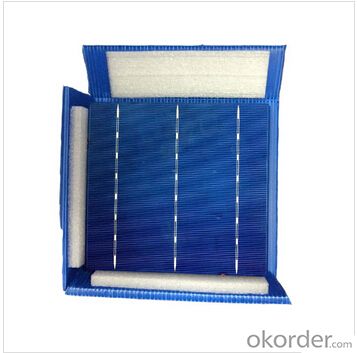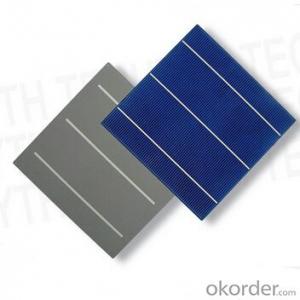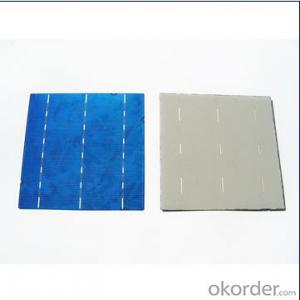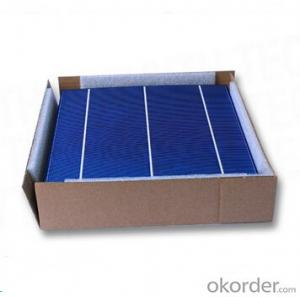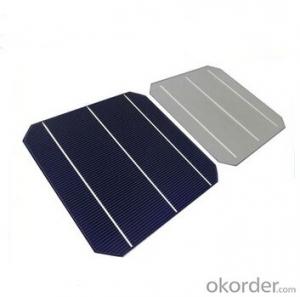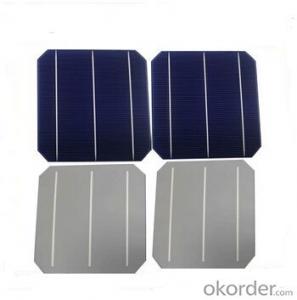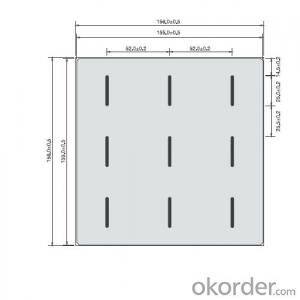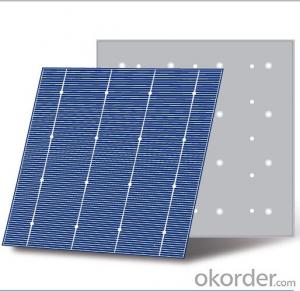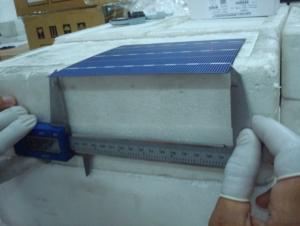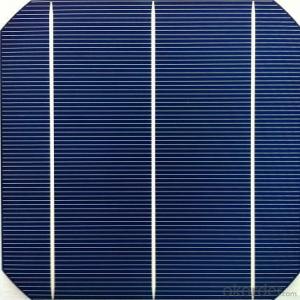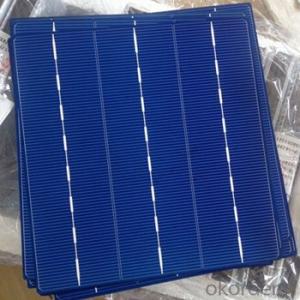Multiband Polycrystalline Solar Cells Series - CM16.80
- Loading Port:
- Shanghai
- Payment Terms:
- TT or LC
- Min Order Qty:
- 3000 pc
- Supply Capability:
- 300000 pc/month
OKorder Service Pledge
OKorder Financial Service
You Might Also Like
Solar Cells:
Solar cells is made by solar wafer, it has three categories of solar cell right now, monocrystalline polycrystalline and thin film,These cells are entirely based around the concept PN junction, which is the critical part of solar module, it is the part that can convert the light energy into electricity, the thickness is from 180um to 200um, with even busbars to conduct electricity, textured cell can decrease diffuse reflection; they are often electrically connected and encapsulated as a module. Photovoltaic modules often have a sheet of glass on the front (sun up) side, allowing light to pass while protecting semiconductor wafers from abrasion and impact due to wind-driven debris, rain, hail, etc. Solar cells are also usually connected in series in modules, creating an additive voltage. Connecting cells in parallel will yield a higher current;With high quality and stable quality. Our Cells can greatly improve the performance of Solar Modules.
Features:
1. High conversion efficiencies resulting in superior power output performance.
2. Outstanding power output even in low light or high temperature conditions
3. Optimized design for ease of soldering and lamination
4. Long-term stability, reliability and performance
5. Low breakage rate
6. Color uniformity
Solar Cells Advantage:
1. Tire-1 Solar Cells’ Manufacturer Quality Guarantee. With a complete and sophisticated quality government system, our Quality Management have arrived world’s leading place. Customer can receive Tire-1 Cells Maker’s Quality Standard Products.
2. Trusted Warranty. We can supply trusted after-sales service to our customer. If our cells are found not in conformity to the specification of manufacturer, or should the inspected quantity found in shortage, or should the packing found damaged, the buyer has the right to claim to the seller. The claim, if any, should be presented to seller within 30 days after cargo's arrival date to the port, together with related inspection report and photos issued and provided by a reputable independent surveyor such as SGS.
3. World’s Leading Manufacturer Equipment. We imported the newest and leading production equipment from abroad. Advanced equipment can guarantee the stable quality of cells. Auto production line can also save labor cost which will further cut our production cost.
4. Bulk supply: With the production capacity of 500MW, we can produce large quantity every month. This can satisfy most customer requirement.
Specifications:
Kit content:
Product: multicrystalline cell based on poly silicone
Format: 156mm*156mm ± 0.5mm
Front contacts (-): 3*1.5mm wide bus bars(silver), acid texturized surface, blue silicone nitride antireflection coating
Back contacts (+): 3*3mm wide bus bars(silver/aluminum), aluminum backside metallization
Warranty:
Repairs: For repairs please contact to us
Exchange service: You can choose between a refund, exchange or credit where goods are faulty or doesn’t do what it supposed to do
Model | CM16.80% |
Max power | 4.1W |
Short-circuit current(Isc) | 8.41A |
Imax at 0.5V | 8A |
Open circuit voltage(Voc) | 0.62V |
Size | 156*156mm |
Efficiency | 16.80% |
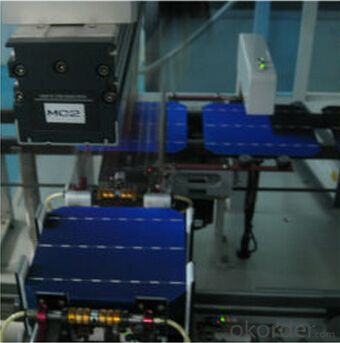
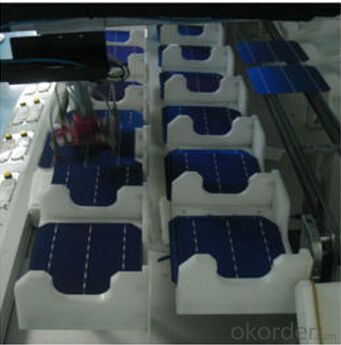
FAQ
We have organized several common questions for our clients,may help you sincerely:
①What price for each watt?
It depends on the efficiency of the solar cell, quantity, delivery date and payment terms.
②How long can we receive the product after purchase?
In the purchase of product within three working days, We will arrange the factory delivery as soon as possible. The pecific time of receiving is related to the state and position of customers.Commonly 7 to 10 working days can be served.
③Can you provide the peripheral products of the solar panels, such as the battery, controller, and inverter? If so, can you tell me how do they match each other?
Yes, we can, we have two companies for solar region, one is CNBM International, the other is CNBM engineering Co.
We can provide you not only the solar module but also the off grid solar system, we can also provide you service with on grid plant.
④What is your warranty of solar cell?
Our product can promise lower than 0.3% open box crack, we support claim after opening the box if it has crackm color difference or sth, the buyer should give pictures immediately, we can not accept the claim after the solar cell has assembled to solar panel.
• Timeliness of delivery
• ⑤How do you pack your products?
We have rich experience on how to pack the solar cell to make sure the safety on shipment, we could use wooden box or pallet as buyer's preference.
How Much Do Solar Panels Cost
How much do solar panels cost? This is undoubtedly the question we`re asked the most, and unfortunately it has no straightforward answer. We decided to pull together all aspects of this question, and write the best resource on the costs of solar panels you will find on the entire Internet.
Residential solar systems are typically sized from 3 to 8kW and end up costing between $15,000 and $40,000. The cost per watt (price inclusive of parts, labor, permitting fees, overhead, and profit) has decreased significantly over the last decade and is now between 6 and 8 ($/W) in many parts of the U.S. Generally, the bigger the system, the lower the cost per watt.
The total costs are split into system, installation and operational costs, roughly in the following ratios:
Contents

How Much Do Solar Panels Cost Today?
Solar panels themselves are now a global product. There’s tremendous variation in the cost of solar panels based on the type and efficiency of the solar panels. However, the type of panels used for residential solar installations is quite standard and the costs are basically set globally. That cost has fallen tremendously within the past few years — they’re now about half the price they were in 2008, and more than 100 times lower than they were back in 1977.
The average weekly spot price for polysilicon solar modules this week is $0.55/watt. For a thin-film solar modules, it’s $0.55/watt. For residential solar modules, which are typically of a higher efficiency than solar modules used in utility-scale solar farms, the figure would be a bit higher. But how much does this solar cost info really help you?
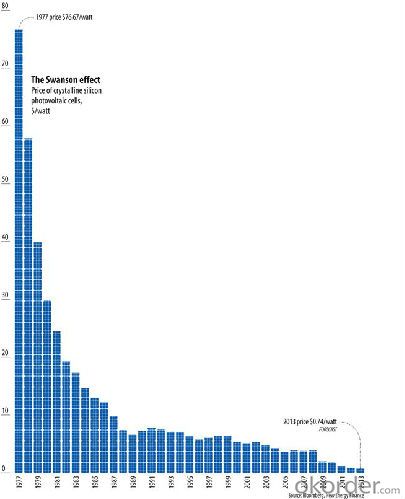
- Q: How long is the long cycle solar cell life?
- A look at the application of the environment, if the ambient temperature is high, then in general, to 25 degrees as a benchmark, each increased by 10 degrees, life-span reduced by half;
- Q: What is the solar cell production process
- The battery is also known as a "photovoltaic cell", the semiconductor material used for solar cells is a special substance between the conductor and the insulator.
- Q: What is the impact of shading on solar cell performance?
- Shading has a significant negative impact on solar cell performance. When a solar cell is partially shaded, it reduces the amount of sunlight reaching the shaded area, leading to a decrease in power generation. This is because shading disrupts the flow of electrical current within the solar cell, resulting in reduced efficiency and overall output. Even a small amount of shading, such as from trees, buildings, or debris, can have a noticeable impact on the performance of the solar cell. Therefore, it is important to carefully consider the placement and positioning of solar panels to avoid shading and maximize their efficiency.
- Q: How do solar cells perform in areas with high levels of industrial emissions?
- Solar cells can perform less efficiently in areas with high levels of industrial emissions due to the presence of air pollutants. These emissions can create a layer of grime on the surface of solar panels, reducing their ability to absorb sunlight. Additionally, air pollution can scatter and block sunlight, further reducing the overall performance of solar cells in such areas. Regular cleaning and maintenance of solar panels may help mitigate the impact of industrial emissions on their performance.
- Q: How do solar cells affect the value of a property?
- Solar cells can significantly increase the value of a property. They not only provide a reliable and sustainable source of energy, but also reduce electricity bills, making the property more attractive to potential buyers. Additionally, solar panels are seen as a valuable asset that can generate income through net metering or feed-in tariffs, further increasing the property's value.
- Q: Can solar cells be used for desalination purposes?
- Yes, solar cells can be used for desalination purposes. Solar-powered desalination systems, such as solar stills and solar desalination plants, harness the energy from the sun to power the desalination process. This renewable energy source helps reduce the environmental impact of desalination and promotes sustainable water production.
- Q: How are solar cells made?
- Solar cells are typically made using a process called photovoltaic manufacturing, which involves several steps. First, silicon, which is the main material used in solar cells, is extracted from silica, a component of sand. The extracted silicon is then purified and transformed into a crystal structure suitable for solar cell production. These silicon wafers are then cut into thin slices. Next, various layers of conductive materials and anti-reflective coatings are applied to the wafer, creating the necessary electrical properties and enhancing light absorption. Finally, electrical contacts are added to the cell, allowing the generated electricity to be collected and used.
- Q: How do solar cells handle shading or obstructions?
- Solar cells are designed to handle shading or obstructions by using bypass diodes. These diodes allow the current to bypass the shaded or obstructed area, ensuring that the remaining unshaded cells can still generate electricity. This helps minimize the impact of shading or obstructions on the overall performance of the solar panel.
- Q: Can solar cells be used in electric vehicle charging stations?
- Yes, solar cells can be used in electric vehicle charging stations. Solar panels can generate electricity from sunlight, which can then be used to charge electric vehicles. This provides a sustainable and renewable energy source for charging stations, reducing dependency on traditional power grids and reducing carbon emissions.
- Q: Can solar cells be used in weather monitoring systems?
- Yes, solar cells can be used in weather monitoring systems. Solar cells are used to convert sunlight into electrical energy, which can power various components of weather monitoring systems such as sensors, data loggers, and communication devices. This allows for autonomous and sustainable operation of weather monitoring systems in remote locations where access to traditional power sources may be limited.
Send your message to us
Multiband Polycrystalline Solar Cells Series - CM16.80
- Loading Port:
- Shanghai
- Payment Terms:
- TT or LC
- Min Order Qty:
- 3000 pc
- Supply Capability:
- 300000 pc/month
OKorder Service Pledge
OKorder Financial Service
Similar products
Hot products
Hot Searches
Related keywords



